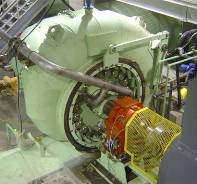Rancho Penasquitos Pressure Control Hydroelectric Facility

The Rancho Penasquitos Pressure Control/Hydroelectric Facility (RP PCHF) is located in a neighborhood near Mira Mesa, California.
Summary
The San Diego County Water Authority is a public agency working through its 24 member agencies to provide a safe, reliable water supply to support the region’s three million residents and $150 billion economy. The Rancho Penasquitos Pressure Control Hydroelectric Facility (RP PCHF) is an important addition to the Water Authority’s extensive water delivery system and includes a 4.5-MW hydroelectric generator and four sleeve valves.
The RP PCHF provides several major benefits. The project improves the flexibility of pipeline operations, eliminating the limitation of moving water in only one direction and increasing the ability to keep water flowing to member agencies. The hydroelectric unit generates clean, renewable energy that reduces the Water Authority’s costs and supplies enough power for 5,000 homes. Using hydroelectric power instead of fossil fuels avoids emissions of more than 200 tons of sulfur dioxide and nitrous oxide annually.
The Water Authority and San Diego Gas and Electric Company also entered into a 10-year contract for the purchase of power generated by this facility that will help stabilize water rates for the ratepayers and offset the Water Authority’s operations and maintenance expenses.

The Horizontal Francis Turbine Generator allows the RP PCHF to generate 4.5 MW of clean, reliable power.
Background
The San Diego County Water Authority is a public agency serving the San Diego region as a wholesale supplier of water that services more than 24 million local residents.
In 1989, the San Diego County Water Authority launched a Capital Improvement Program (CIP) to improve the pipeline delivery system and to make the method of supplying the water throughout the county more flexible. The Water Authority is not only committed to improving water reliability within the region by tapping into local sources, but also to offering energy savings where possible.
The Water Authority’s Board adopted an energy strategy in 2001 that seeks to work in coordination with local energy programs, develop economical energy supplies, and monitor ongoing developments in the energy market. State legislation extended this strategy by authorizing the Water Authority to enter wholesale energy markets, sell power to any retail electricity provider, own and operate electric-power generation facilities, and conduct other energy-related activities.
The Water Authority demonstrated its commitment and leadership by taking the initiative to design and construct the 4.5-MW Rancho Penasquitos Pressure Control and Hydroelectric Facility (RP PCHF), a key ingredient in the CIP water delivery system.

From left to right: NHA President Leslie Eden, Betty Ferguson, Chair of San Diego County Water Authority’s Engineering and Operations Committee; Kelly Rodgers, Julie Smith-Galvin, and Don Froelich.
ChallengeThe Water Authority faced several challenges in developing and implementing the CIP. For example, although water reliability during earthquakes is a high priority, two key aqueducts sit between major faults. Pipeline designs that rely on gravity to move water allowed for transfers only in one direction, severely limiting the Water Authority’s ability to move water around the region during shortages.
Innovation
The $21 million RP PCHF involved implemented, coordinated, and innovative engineering approaches to enhance existing systems and offer new services. By pressurizing a 22-mile section of pipeline, the Water Authority created new water delivery and management options for the region. At the same time, the pressurized flows also created a new clean-energy resource for the area. Not only is the Water Authority able to service customers more effectively, but it now supports state energy and environmental goals through its electricity generation and enjoys a revenue stream that helps stabilize ratepayer costs.
Results
The $21 million project offers several key benefits to the region:
- The improved pipeline operations provides more flexibility for moving power throughout the region by creating a pressurized, bi-directional system that keeps water flowing to member agencies.
- High-pressure flows in the pipelines are also allowing the Water Authority to generate electricity through a 4.5-MW turbine generator. This year-round operation provides a clean energy resource to the area and avoids the emissions associated with generating electricity through fossil-fuel plants.
- Through a 10-year contract with the San Diego Gas and Electric Company, the Water Authority will be able to sell electricity to the utility, which reduces the need to import power from other regions and resources. Generating this electricity offers the Water Authority a revenue stream estimated at $1.3 million to $1.6 million per year, which reduces costs and helps stabilize consumer costs.
Stakeholder Quotes
“The San Diego County Water Authority showed great foresight in building a facility that would meet diverse demands and incorporate environmentally sustainable technology by making use of a completely renewable energy source. Successful completion of this multi-faceted facility also required a combination of water and energy expertise found in very few companies. By making use of available hydraulic pressure, this water facility is able to generate substantial electricity without harmful emissions.” — Dan McCarthy, President and CEO, Black & Veatch Global Water Business


